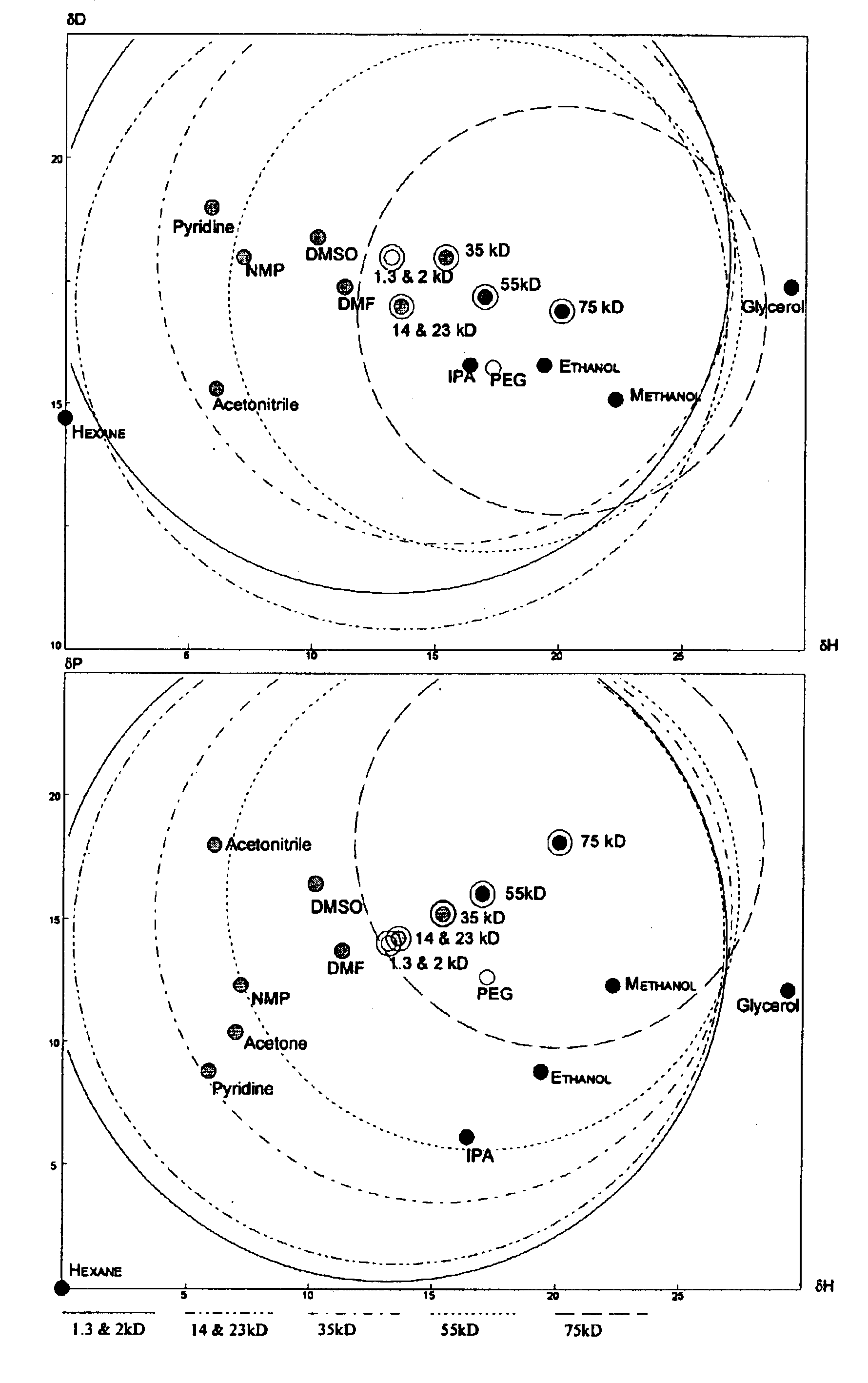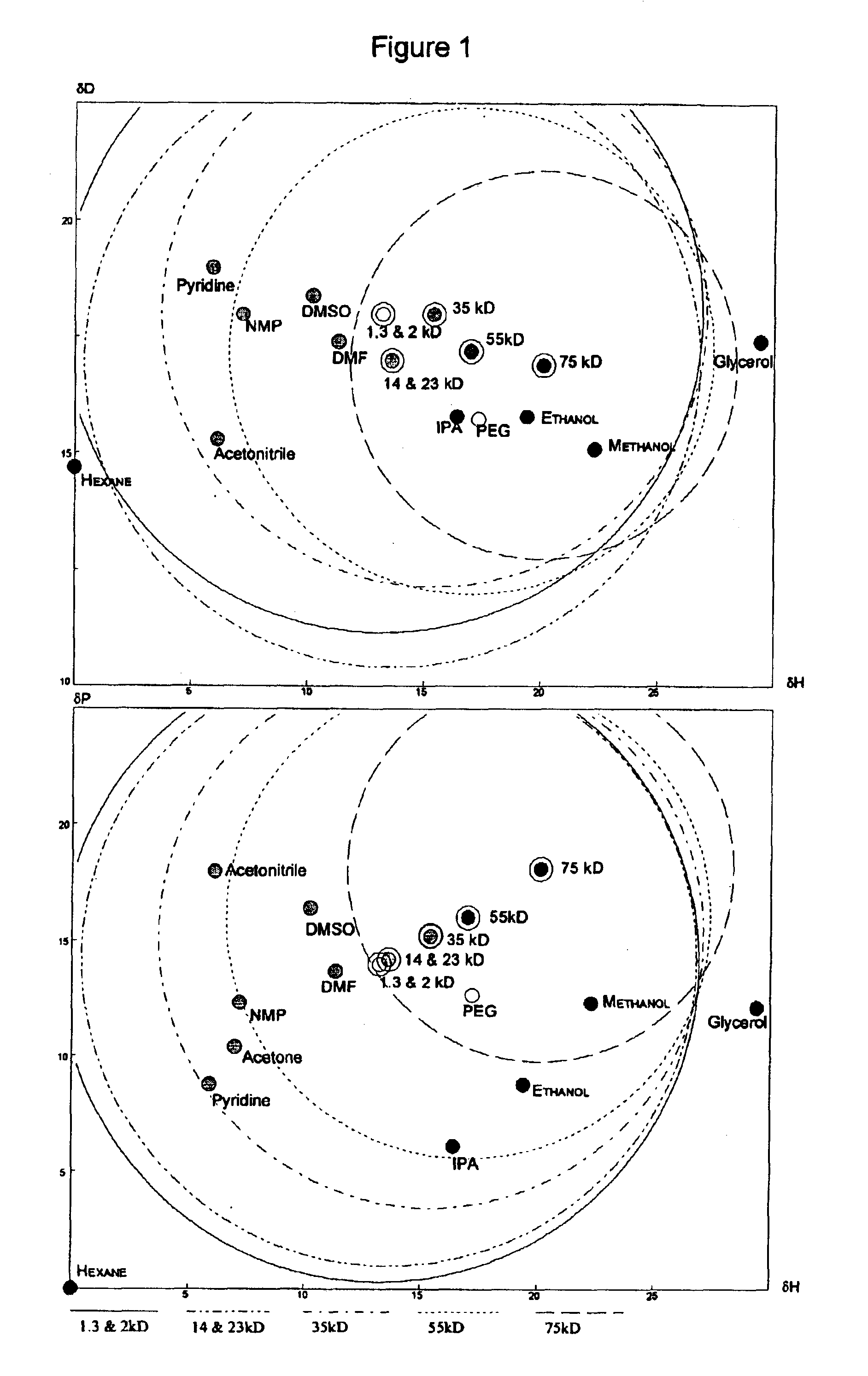Low polydispersity poly-HEMA compositions
a composition and low polydispersity technology, applied in the field of polyhema compositions, to achieve the effect of soft contact lenses and excellent mechanical properties
- Summary
- Abstract
- Description
- Claims
- Application Information
AI Technical Summary
Benefits of technology
Problems solved by technology
Method used
Image
Examples
example 1
1911.6 g ethanol, 1056.6 g HEMA monomer, 3.00 g dodecyl mercaptan, and 21.00 g methacrylic acid were blended at 25° C. The mixture was poured into a 5-liter stainless steel reactor with a three-blade stirrer, temperature control and a jacket for cooling and heating.
The mixture was heated to 68° C., and 7.50 g 2,2′-azobis(2-methylbutyronitrile) (AMBN) was added. The AMBN dissolved rapidly, and the reactor was blanketed with a slow stream of nitrogen. The temperature was held at 68° C. for 18 hours to complete conversion. The reactor was heated to 80° C. and kept at this temperature for 22 hours to destroy residual initiator and mercaptan. After cooling to room temperature a sample was withdrawn and solid content determined by evaporation at 125° C., 3-4 mm Hg for 24 hours. Solid content=37.2%. Mp=76.6 kDalton, Pd=3.75.
The poly-HEMA solution was diluted with ethanol to give a 10% solution of poly-HEMA in ethanol. The solution became turbid at 24° C. The solution was heated to 40° C. t...
example 2
HEMA monomer (with an impurity level lower than 0.8% purchased from Rohm) was mixed with triethylamine (≧99.5% pure, from Fluka) and petrol ether (bp 40-60° C.) passed through aluminum oxide and reacted with trimethyl chlorosilane (≧99.0% pure, from Fluka) to obtain trimethylsilyloxyethyl-methacrylate (TMS-HEMA). TMS-HEMA was purified by distillation from calciumhydride (once) and triethylaluminum (electronic grade, from Aldrich) (twice).
The polymerization of TMS-HEMA was carried out in THF (abs. puriss.), solution (Fluka) at −78° C. using 1,1-diphenylhexyl lithium as initiator and resulted in a quantitative yield. The polymerization was terminated by degassed methanol. The polymer was isolated by adding the THF solution of poly(trimethylsilyloxyethyl-methacrylate) p(TMS-HEMA) to a large excess of water.
The polymer had a peak molecular weight of 63 kD, Mw=75 kD and a polydispersity of 1.6.
example 3
1619 g ethanol, 176.5 g HEMA monomer, and 3.60 g methacrylic acid (MAA) were blended at 25° C. The mixture was poured into a 3-liter glass reactor with a stirrer, temperature control and a jacket for cooling and heating.
The mixture was heated to 68° C., and 1.26 g AMBN was added. The AMBN dissolved rapidly, and the reactor was blanketed with a slow stream of nitrogen. The temperature was held at 68° C. for 20 hours to complete conversion. After cooling to room temperature the polymer solution was diluted with ethanol to give a 10% solution of poly-HEMA in ethanol. The Mp was 70 kD and Pd was 3.33 before fractionation. After addition of 2% hexane the solution had a cloud point of 31° C. The polymer was fractionated in Example 10.
PUM
| Property | Measurement | Unit |
|---|---|---|
| polydispersity | aaaaa | aaaaa |
| polydispersity | aaaaa | aaaaa |
| polydispersity | aaaaa | aaaaa |
Abstract
Description
Claims
Application Information
 Login to View More
Login to View More - Generate Ideas
- Intellectual Property
- Life Sciences
- Materials
- Tech Scout
- Unparalleled Data Quality
- Higher Quality Content
- 60% Fewer Hallucinations
Browse by: Latest US Patents, China's latest patents, Technical Efficacy Thesaurus, Application Domain, Technology Topic, Popular Technical Reports.
© 2025 PatSnap. All rights reserved.Legal|Privacy policy|Modern Slavery Act Transparency Statement|Sitemap|About US| Contact US: help@patsnap.com



